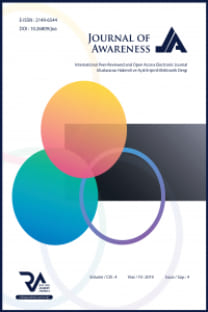BOBİN BOYAMA KALİTESİNİN İYİLEŞTİRŞLMESİ VE İPLİK TELEFLERIİNİN AZALTILMASI ÜZERİNE BİR ARAŞTIRMA
İplik boyama yöntemleri arasında bobinde boyama en yaygın kullanılan yöntem olarak bilinmektedir. Düşük üretim maliyetine, kullanım kolaylığına ve kaliteli boyama özelliğine sahip olması bu yöntemin en büyük avantajıdır. Boyama prosesinin verimliliği ve boyanan ipliğin kalitesi ipliğin cinsine, kullanılan boyarmaddenin tipine, boyama rejimine ve boyama parametrelerine bağlıdır. Bunun yanında boyanan ipliğin kalitesini bobinin sarım yapı parametreleri ve boyama patronunun yapısı önemli derecede etkilemektedir. Bu çalışmada boyama patronun yapısının boyama kalitesine ve boyanmış iplikten oluşan iplik telef miktarına etkisinin deneysel incelenmesi gerçekleştirilmiştir. Deneyler, reaktif boyalarla boyama sırasında farklı patronlara sarılmış farklı numaralı pamuk iplikleri için yapılmıştır. Araştırma sonucunda boyanmış ipliğin kalitesinin iyileştirilmesine ve iplik teleflerinin azaltılmasına yönelik önemli tespitler elde edilmiştir.
Anahtar Kelimeler:
İplik, Bobin boyama, Patron yapısı, boyama kalitesi, iplik telefleri
A STUDY ON IMPROVİNG THE QUALİTY OF THE BOBBİN DYEİNG AND REDUCİNG YARN WASTE
Among the yarn dyeing methods, dyeing in the bobbin is known as the most commonly used method. Low production costs, ease of use and high quality dyeing feature are the most important advantages of this method. The efficiency of the dyeing process and the quality of the dyed yarn depend on the type of yarn, the type of dyestuff used, the dyeing recipe and the dyeing parameters. Besides, the winding structure parameters of the bobbin and the structure of the dyeing tops significantly affect the quality of the dyed yarn. In this study, the effect of the bobbin structure on the dyeing quality and the amount of yarn waste of dyed yarn was investigated experimentally. The experiments were carried out for different numbered cotton yarns wrapped in different tops during dyeing with reactive dyes. As a result of the research, important results have been obtained for improving the quality of the dyed yarn and reducing the yarn waste.
Keywords:
Yarn, bobbin dyeing, tops structure, dyeing quality, yarn waste,
___
- Aniş P., 1998, ‘Tekstil Ön Terbiyesi’, Uludağ Üniversitesi, Tekstil Mühendisliği Bölümü, Alfa Basım Yayın Dağıtım, İstanbul, s 204.
- Area to The Dyeing Quality of Yarn Bobin” 16. th International Conference Structure and Structural Mechanics of Textile Liberec)
- Fetahov R., Palamutcu S., Altıntaş M., 2009, “Influence of Tube Dye Transfer Surface
- Fettahov R. M., (1991) Bobinde İplik Boyama Kalitesinin İyileştirilmesi Yöntemleri. Azerbaycan Teknoloji Enstitüsü Bilimsel Yayınları. Bildiriler Kitabı, 37-45 s.
- Fettahov R., Kaplan V., Keskin R. ve Şimşek G., 2005, ‘Terbiye ve Boyama Amaçlı Patronlar Üzerine Bir Araştırma’, Tekstil Maraton, Eylül- Ekim 5, 18-22s.
- Lewis D. M. 1992, ‘Wool Dyeing’ Society of Dyeing and Colorists, Leeds, UK, pp 153- 161.
- Mariplast-Yarn package dyeing-Dye tubes - Dye–Dye springs. http: /www. sanalplastik. com/
- Palamutçu S., Fettahov R., 2010, “Yüksek Performanslı Boyama Patronu” Avrupa Patenti, No: EP 2 083 106A1.
- Selene. M. A. ve diğ. Modellung of the dyeing process of packad cotton threards
- Usıng reactive dyes. Tran Porous. Med (2007) 68.341-363 DOI 10.1007/s 1242-006- 9046-7 www.at-otex.com
- Yang Y., Mattison V. L., 1997, ‘ The Effect of Package Density Profile on Levellness of Package Dyed Yarn’, Textile Chemist and Colorist, Vol: 29(8), pp: 77-81.
- Андросов В. Ф. и dr.(1974) Крашение пряжи в поковках. Изд. ЛИ, Москва, 225 ст.
- Киселев Н.В. Развитие теории процессов распределения рабочих сред и совершенствование аппаратов для жидкостей обработки и сушки текстильных паковок: Дис. на соис. уч.зв. докт. техн. наук. – Кострома: КГТУ, 2008.
- ISSN: 2149-6544
- Başlangıç: 2016
- Yayıncı: Rating Academy
Sayıdaki Diğer Makaleler
VİZYON BİLDİRİMLERİNDE İNOVASYON: TÜRKİYE'DEKİ BÜYÜKŞEHİR BELEDİYELERİ ÖZELİNDE BİR DEĞERLENDİRME
Filiz Tufan EMİNİ, Çağlar Eren AYAZ
SAĞLIK HİZMETLERİNDE İYİLEŞTİRME VE HASTA GÜVENLİĞİ İÇİN TIBBİ HATALAR VE MALPRAKTİS NEDENLERİ
MEME KANSERİNİ ÖNLEMEDE İHMAL EDİLEN BİR GRUP: BİRİNCİ DERECE YAKIN AKRABALAR
ÇANAKKALE TURİZMİNİN KARBON AYAK İZİ ÜZERİNE BİR ARAŞTIRMA
TÜRKİYE’DEKİ INSARAG UYUM SÜRECİNİN KATILIMCI GÖZLEMCİ YÖNTEMİ İLE ARAŞTIRILMASI
Çağla KARAKAŞ ATEŞ, Yusuf Arif KUTLU
REKABETÇİ İŞBİRLİĞİ ANLAŞMALARINDA İŞBİRLİKÇİ PROFİLİNİN SEKTÖREL DÜZEYDE ANALİZİ
